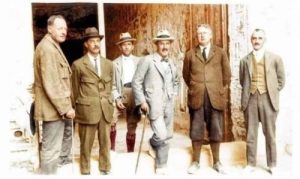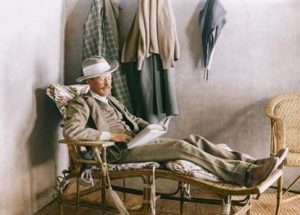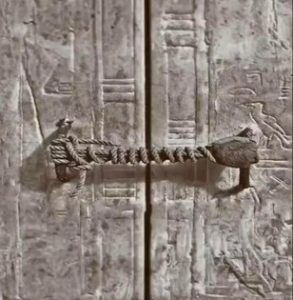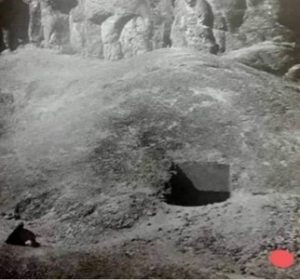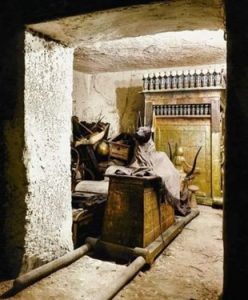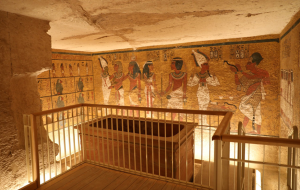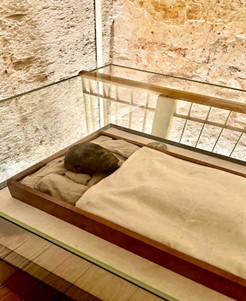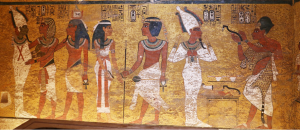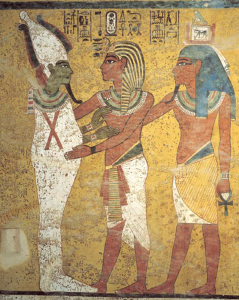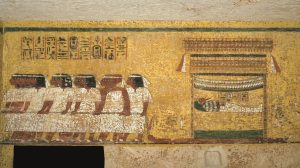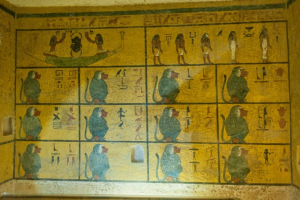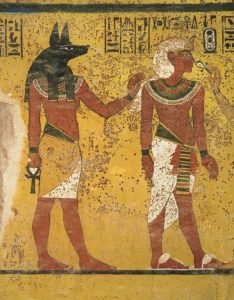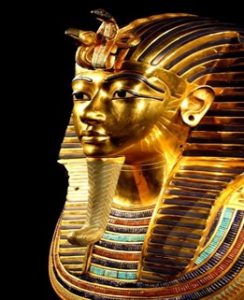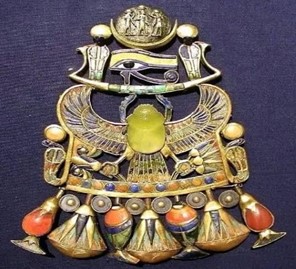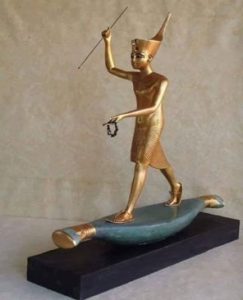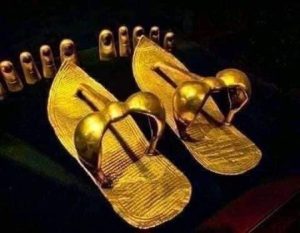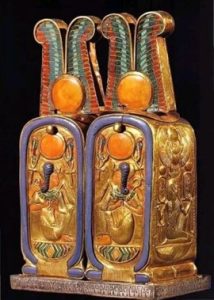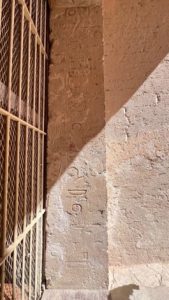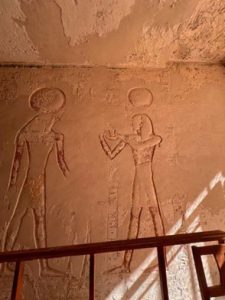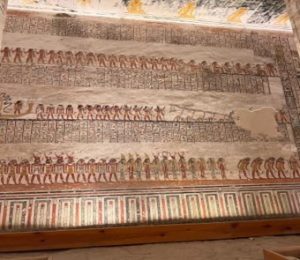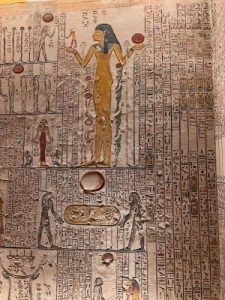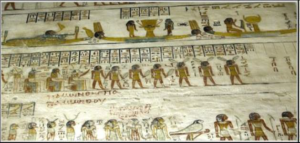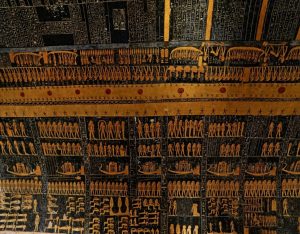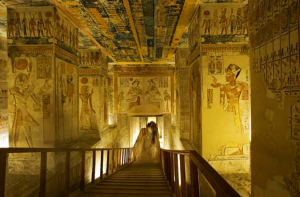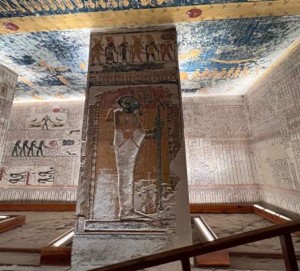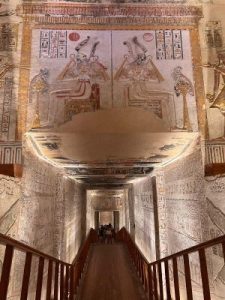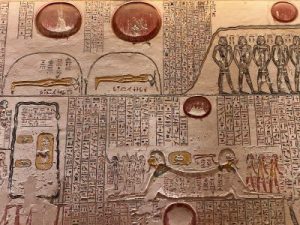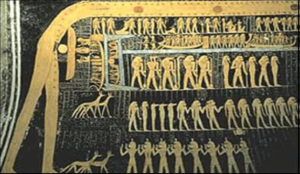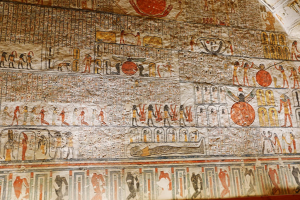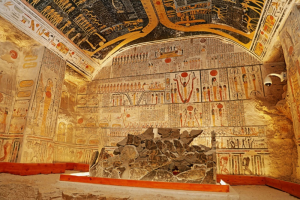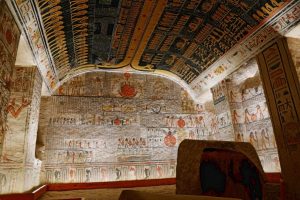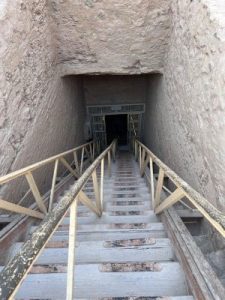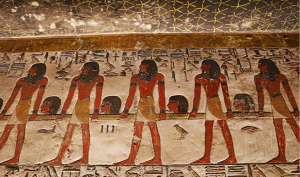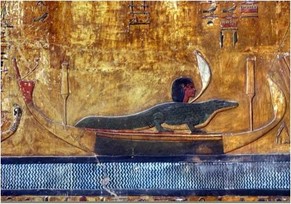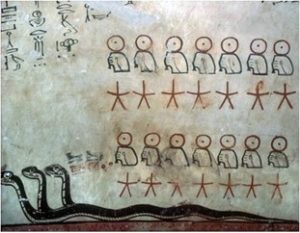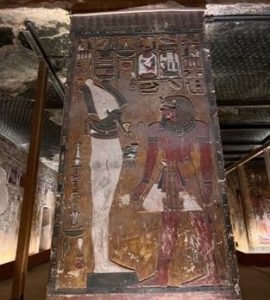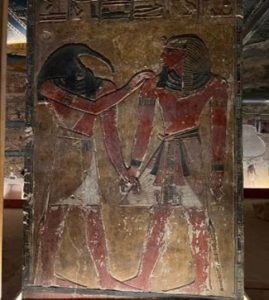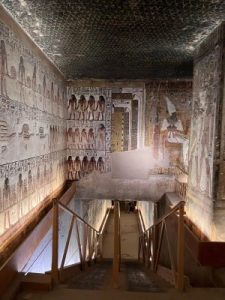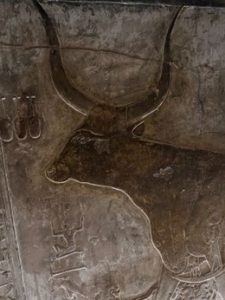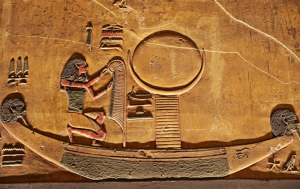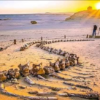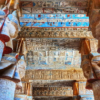The Tomb of Tutankhamun
The most important archaeological discovery in the history of the world was the discovery of the tomb of the young king Tutankhamun on November 4, 1922, by the British archaeologist Howard Carter. It is known that all the tombs of the kings of Egypt, whether pyramids or royal tombs in the Valley of the Kings, had been robbed, so we did not find any complete royal tomb until we found the tomb of Tutankhamun. Carter found no less than 5,000 precious pieces of gold and stone treasures, the most famous of which is the famous mask of King Tutankhamun. In addition to three sarcophagi for the king: The first is made of sandstone and its lid is made of granite, and inside it is the second sarcophagus. The second sarcophagus is made of gilded wood and inside it is the third sarcophagus. The third sarcophagus is made of pure gold and inside it was found the golden mask of the king and the mummy of the king. Each sarcophagus was decorated with the four protective goddesses (Isis, Nephthys, Selket, and Neith).
Carter, the Discoverer of the Tomb, and Lord Carnarvon, the Financier
The Reason for the Complete Discovery of the Tomb
When constructing the largest tombs in the Valley of the Kings, which was the tomb of Ramsis VI, the workers were digging and throwing the debris onto the small tomb of Tutankhamun, thus blocking its entrance, and then the debris completely covered it. This is what helped us discover this amazing discovery of treasures belonging to a king who ruled for only 9 years and died young. So, imagine if we found the tomb of a great king like Thutmose III or Ramses II with all its contents intact?
King Tutankhamun
After the death of Akhenaten, his son King Tutankhamun ascended the throne at the age of about 9 years and was married to his half-sister Smenkhkare (daughter of Akhenaten and Nefertiti). King Tutankhamun initially ruled from Tell el-Amarna (Akhetaten), the city of his father Akhenaten, but the priests in Thebes convinced him to return to Thebes and rule from there. So, he returned to the religion of Amun and changed his name from Tutankhaten to Tutankhamun. Tutankhamun means “the living image of the god Amun”. Due to his young age, his vizier Ay was the one who ruled with him. Tut was fond of hunting in his chariot, and on one occasion, the chariot overturned and his leg was broken, so he started walking with a cane. This is why we found many canes in his tomb. After scientists conducted DNA tests recently (between 2022 and 2024), they discovered that the king was suffering from something similar to malaria. This is why Dr. Zahi Hawass believes that he died from this disease, which explains the presence of many grains in the tomb, the most famous of which is fenugreek, as it treats this disease. When the body was discovered, a hollow hole was found in his head. Some believe that it was an axe with which he was assassinated, while others believe that it occurred during the mummification process. Since the king ruled at a young age and died young (he ruled at the age of nine and died at the age of 18), it is believed that this tomb was originally intended for his vizier Ay (who was later buried in another tomb). So the king was buried in this small chamber, and we find in it that Ay wears the crown as a king after Tutankhamun and wears a leopard skin (acting as the high priest) and performs the opening of the mouth ritual for King Tutankhamun. The funerary furniture was buried with the king and everything he needed in the afterlife, even beds and sandals, all of which were made of gold or gilded, which indicates the wealth that Egypt was characterized by during that period. Most of the treasures of the tomb were transferred to the Egyptian Museum in Tahrir Square, Cairo, and were transferred this year (2024) to the Grand Egyptian Museum near the pyramids. Carter also took many artifacts and transferred them to Britain, and some were sold and are now in some international museums.
Important Images of Tutankhamun’s Tomb
Tutankhamun’s chamber was closed when the tomb was discovered
Image from 1922 when the tomb was discovered
First image of the discovery of the tomb interior
Burial chamber of King Tutankhamun
Mummy of King Tutankhamun inside his tomb in the Valley of the Kings on the West Bank of Luxor
Scene of the opening of the mouth ritual: King Ay with leopard skin performing the opening of the mouth for the mummy of the king, then in the middle is a young king with his wife
King Tut and his Ka or Ba, and he is embracing Osiris
Funeral procession
12 monkeys representing the twelve hours of the night, details from the first hour of the Book of Amduat
King Tutankhamun with Anubis behind him Some treasures from Tutankhamun’s Tomb
Mask of Tutankhamun
Breastplate of King Tutankhamun
The king hunting with a spear inside his golden chariot
Sandals of King Tutankhamun made of gold
Cosmetics box of King Tutankhamun
Ramses VI (approximately 1443-1136 BC)
Ramses VI was one of the sons of Ramses III and succeeded his nephew Ramses V to the throne, ruling for eight years. He tasked the workers of Deir el-Medina with completing the tomb of Ramses V, which he had usurped, and built one of the most beautiful tombs in the Valley of the Kings, 93 meters deep. He expanded the tomb and used it for his burial. The plan of the tomb was simple; it consisted of a group of descending corridors in a straight line leading to the burial chamber deep underground, and its inscriptions were in a good state of preservation.
Names of the tomb
The French expedition called it the “Tomb of the Embodied Soul.” The English called it the “Tomb of Memnon” (due to the similarity of the coronation name of King Ramses VI to the coronation name of King Amenhotep III, the owner of the Memnon Colossi). It was called the “double tomb” because the burial chamber ends with a small chamber, so they considered it as if it were two burial chambers.
Description of the Tomb of Ramses VI (KV9)
On the lintel above the entrance, we see a scene depicting the solar disk (Ra) with Khepri (the scarab) inside it, then Atum with a ram’s head, representing the sun at dawn, noon, and dusk. On the shoulders of the door, the names of King Ramses VI are inscribed within cartouches. The tomb’s scenes contain many funerary inscriptions that help the king transition peacefully to the afterlife. The first descending corridor was decorated with the Book of the Gates, the Book of the Caves, and the Book of the Sky. The following corridors were decorated with scenes from the Book of Amduat (meaning “that which is in the underworld”), the Book of the Dead, and the Book of the Sky. While the burial chamber was decorated with scenes from the Book of the Earth. The ceilings were decorated with astronomical scenes and inscriptions. Some of these funerary texts are a collection of spells, while others are maps of the underworld, describing the daily nightly journey of the sun god through it, which allows the king to ensure his rebirth on the eastern horizon at dawn like the sun god.
Scene of the names of King Ramses VI inside cartouches on the lintel of the door at the entrance of the tomb
The First Corridor
On the left of the entrance, we see a scene of the king in front of various deities, followed by texts and scenes from the first and second chapters of the Book of the Gates. On the right, we find a scene of the king offering incense to the god to expel evil spirits from his tomb. Then we find scenes from the Book of the Caves, characterized by the presence of oval shapes, which are coffins containing gods and the dead.
The Second Corridor
On the outer lintel of the corridor, we see the winged solar disk. On the left, we notice chapters from the Book of the Gates, and the most beautiful of them is the fourth chapter of the Book of the Gates, where we find the Hall of Osiris (the scene that the French believed represented the transmigration of souls). On the right side of the corridor, there are scenes from the second and third chapters of the Book of the Caves.
The Third Corridor
The same pattern is on the left, the Book of the Gates, and on the right, the Book of the Caves.
The Inner Corridor of the Tomb
A scene of the king offering offerings to the god Ra-Hor akhty
A scene of pulling boats in the underworld, in front of which are rows of gods carrying knives to cut off the head of the serpent Apophis
A scene from the third corridor from the Book of the Caves
The Ceiling of the Tomb
The tomb of Ramses VI is unique with its distinctive ceiling scenes and of great importance due to the presence of astronomical tables and their symbols, and the complete depiction of the Books of Night and Day, as this book was not depicted except in this tomb. Many important constellations were depicted on the ceiling of the tomb. As the ancient Egyptians believed that the sky goddess Nut gave birth to the sun in the morning and swallowed it at night, so during the day the sun traveled in its boat on the body of Nut, and at night the sun’s boat was pulled by a group of deities called the tireless stars inside the body of the sky goddess. The Book of Day appears on the eastern side, representing the scene of the birth of the new sun from the womb of Nut with a bright yellow color and blue stars, and the red solar disk is carried by the winged scarab, and below the winged scarab appears a goddess in the form of a pregnant woman carrying the solar disk, kneeling on her knees in a frontal position between Isis and Nephthys sitting in a side position, and inside the disk appears a small child in great detail. And in the first hour, the goddesses Isis, Nephthys, and Nut appear, supported by the god Shu, who appears standing on a large boat with a curved stern, accompanied by six goddesses. And we see the river represented in the form of a trapezoid in a light blue-sky color, and inside it is two boats for day and night.
Scene of the astronomical tables
Scenes of the tomb ceiling with the Book of Day depicted
Ceiling decorated with the vulture (the goddess Nekhbet)
The Well Chamber
On the left is the Book of the Gates and on the right is the Book of the Caves.
The Hall of Four Pillars
On the pillars are scenes of the king with the gods. As for the walls of the hall, on the left is the Book of the Gates, and we find the famous scene representing the god Nun in the form of a man emerging from the primordial waters, raising the solar boat in which the god Khepri (the scarab) is located as a symbol of the birth of a new day for the sun (this indicates the rebirth and new life of the deceased). And we find the gods working as sailors, and Isis and Nephthys in the form of snakes, and above the head of Osiris, we find the goddess Nut receiving the rising sun. On either side of the corridor between the pillars in the hall, we notice a scene of the goddess Nekhbet, and below her is the goddess Neith in the form of a serpent. On the right, we notice the goddesses Meretseger and Selket, goddesses of death.
The Hall of Four Pillars
one of the pillars in the four-pillar hall
A Small Chamber Before the Burial Chamber
We find scenes depicting the king before the gods of magic. Then he worships in front of two pools and some baboons (a symbol of the god Thoth) and then worships Maat (the goddess of justice). On the ceiling, we find the resurrection of Osiris. king worshipping the god Osiris
View of the king worshiping the god Osiris
The Burial Chamber
It has four pillars in the middle of which is the granite sarcophagus. On the pillars are scenes of the king with the gods, and we notice the celestial ceiling with the Book of Night and Day. On the right on the walls, we see scenes from the Book of the Earth (Aker) with its famous scene symbolizing a reclining lion with two heads facing opposite directions, the west representing yesterday and the east representing today. And from the middle, an arm of the god Nun emerges to receive the solar disk, in the center of which is Khepri with a ram’s head, and two spirts with form of alba birds and human heads worship him. We notice the sun’s boat being pulled by seven alba birds with human heads. And we notice the god Tatenen who points to the primordial earth to receive the solar boat. And we notice the god Nun who lifts the solar disk (four cobra snakes with human heads and human arms pull the solar disk). On the left and inside the sarcophagus chamber, Isis and Nephthys appear on the right. And on the right and left of the river, two small boats appear, and the river begins to flow towards the west, and on each bank, two jackals stand, spirits of the west in golden color, then a procession appears, including many figures, all representing the deceased king, and inside the sarcophagus chamber, jackals appear at the beginning of the fourth and fifth rows with a procession of figures belonging to the king in the bottom row.
The small chamber inside the burial chamber
On its back wall is a view of the twelfth chapter of the Book of Gates (God Nun raises the sun boat).
burial chamber with the king’s sarcophagus
Scene from the Book of the Earth showing a lion with two human heads
The goddess Nut, the goddess of the sky, and inside her are boats pulled by gods in the afterlife
The southern wall of the burial chamber
The northern wall of the burial chamber 1
The northern wall of the burial chamber 2
King Seti I
King Seti I, the son of Ramses I, the founder of the 19th Dynasty, ruled Egypt for at least twenty-one years. After becoming king, he led various campaigns in Libya and Syria to reimpose Egyptian control abroad. King Seti I was the first Egyptian king to fight against the Hittites, who were the new superpower in the Near East, and these activities and military victories were recorded with great skill on the colonnade that began to be built in the temple of Amun at Karnak. King Seti I , ordered the implementation of many large construction projects, both in Karnak and Abydos, and he also built a funerary temple on the west bank of Thebes. During his reign, the depiction of battle scenes began on a large scale on the walls of Egyptian temples, as a way of political propaganda and to announce the king’s power. The reign of the king is attributed to the oldest geological map in the world of gold mines, which is recorded on a papyrus currently preserved in the Turin Museum in Italy. The tomb of King Seti I in the Valley of the Kings (KV 17) is one of the finest and most beautiful royal tombs, as its wall scenes retain their bright colors, including the dark blue color imitating the night sky that appeared on some ceilings.
King Seti I between the gods Horus and Osiris
Entrance to the tomb of Seti I
The tomb of Seti I (KV 17)
was discovered by Belzoni in 1817 and was therefore called Belzoni’s tomb. Its depth is 98 meters.
Description of the Tomb
Corridors On the right are hymns praising Ra. On the left is a scene of the solar triad (Khepri-Ra-Atum). Then we reach a descending staircase, on either side of which are openings in the rock where we see, on the right and left, scenes of demons with their names, then hymns praising Ra. Then we see scenes of Nephthys and Isis kneeling, one of the scenes of the fourth hour of the Book of Amduat (that which is in the afterlife). On the third corridor, on the right is the fourth hour and on the left is the fifth hour of the Book of Amduat. Then we reach the well chamber.
Image from the Book of the Gates recorded on the walls of the tomb
Details from the second hour of the Book of Amduat
Details from the second hour of the Book of Amduat
Details from the fourth hour of the Book of Amduat
The Well Chamber
It is distinguished by very beautiful scenes where we see the king worshipping various gods.
Pillars Halls
Then we enter a hall with four pillars where we find on the left a scene from the Book of the Gates representing the four human forms known to the ancient Egyptians (Egyptian, Asian, Nubian, Libyan). Then we reach a hall with two pillars, on whose walls are depicted in red scenes from the Book of Amduat, but the inscription was not completed. As for the two pillars, they have scenes of the king with various gods
king with the god Osiris
king with the god Thoth
The Corridor
We return to the hall with four pillars and descend from it to a corridor where we see on the right and left similar scenes of the list of offerings, then hymns praising the Eye of Horus, and we notice the famous opening of the mouth ritual.
corridor preceding the burial chamber
The Burial Chamber
It consists of a front part and a rear part. The front part A rectangular chamber with 6 pillars in two rows. The first row of four pillars represents scenes of the king with various gods. As for the two rear pillars, we notice the spirits of the city of Buto with the head of a falcon on the left. On the right are the spirits of the city of Nekhen with the head of a jackal. As for the walls, there are scenes from the Book of the Gates. The rear part It is the most beautiful of the scenes of the Valley of the Kings, with the sarcophagus and the ceiling in the form of a dome representing the sky, and above it is a scene of the goddess Nut bending her body towards the earth. The sarcophagus was taken by Belzoni and is now in the British Museum in London. The five chambers A chamber with four pillars in front of the sarcophagus and two chambers on the right and two chambers on the left.
The most important scenes in the chambers
In the first chamber on the right, the story of the destruction of humanity. A scene of Hathor as a cow with the stars of heaven raised by Shu and swimming above it is the ship of Ra.


